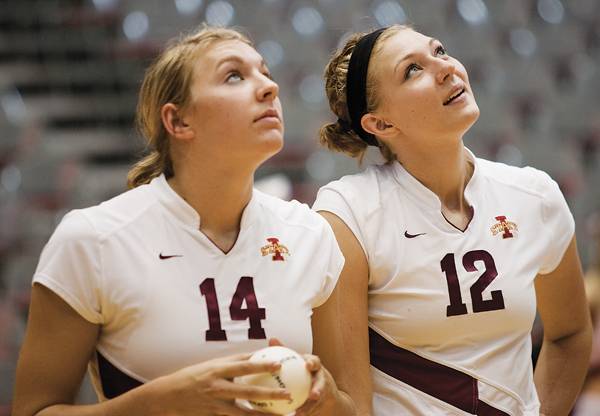ISU athletes dodge H1N1

Iowa State came out victorious after only 3 sets against the University of Kansas Jayhawks. Photo: Gene Pavelko/Iowa State Daily
December 7, 2009
Collegiate athletes, and athletes in general, are known to miss games due to a variety of injuries like pulled muscles, broken bones or concussions.
The H1N1 virus can now be added to that list.
“We’ve seen it in virtually every sport, just like we would see it on any campus,” said Marc Shulman, former chief of staff at Thielen Student Health Center and current team physician for the ISU football team.
H1N1 reached the spotlight of collegiate athletics last May when the University of Delaware canceled a weekend of athletics when the virus was found on campus. In early September, H1N1 was reported to have affected almost a dozen players on the University of Mississippi football team.
The threat of the virus grew stronger for ISU athletics when fellow Big 12 Conference member Texas Tech was forced to reschedule its Sept. 30 volleyball match because six players caught H1N1.
Shulman said athletes aren’t at a higher risk for H1N1, but it can be spread easier because of constant proximity.
“Close contact is a factor in the spread of the virus,” Shulman said. “That’s why we worry about it at practice and travel on bus or plane for extended periods of time.”
According to the Inside Higher Ed Web site, people with the virus should keep a distance of six feet from others, which would make athletic competition somewhat difficult.
A report from the Center for Disease Control even suggested “suspending or modifying” sporting events to further enforce this idea.
Debbie Stadick, sophomore in elementary education and middle blocker for the ISU volleyball team, experienced what it was like to be isolated by the six-foot rule.
Stadick came down with flu-like symptoms in mid-September, but was cleared to travel with the team and compete in matches.
Although it was determined that she didn’t have H1N1, Stadick sat by herself on the team bus, had her own hotel room and had to wear a mask when around her teammates.
“It was up to me if I wanted to travel, but I could tell our trainers didn’t really want me to,” Stadick said. “It was getting to the point where if we looked tired they would have a doctor check us out. It wasn’t a bad thing, we had somebody else get sick, but no one caught it from her as well.”
Mary Meier, athletic training curriculum director and trainer for the ISU volleyball team, acknowledged that there were a few players who were sick, though the team chose not to get tested for H1N1. However, they still followed the basic precautions by isolating them from the team for three to five days.
“What people need to understand is that H1N1 is basically like the flu, so you don’t really want to scare anyone,” Meier said. “We would just monitor anyone who came down with the symptoms.”
Meier said she would keep a constant supply of hand sanitizer at the end of the bench during every match and in the training room. During road matches, Meier would have the team apply it after every set and at the end of the match.
Mark Coberley, assistant athletic director for athletic training and head trainer for the ISU football team, said he has been on alert about the virus last April. When the word of the virus first hit, the athletic department realized that it wasn’t a matter of if, but when it would arrive in Ames.
“It seemed like it traveled by community,” Coberley said. “We got it when Ankeny was getting over it. Even when we knew it was coming, it was still hard because we’re fighting an invisible battle.”
After the football team’s 9—7 victory over Nebraska on Oct. 24, coach Paul Rhoads reported many players had become sick at halftime. While many feared that H1N1 had struck the Cyclones like it struck Ole Miss, Coberley said it wasn’t as bad as people thought.
“The players that were tested for H1N1 didn’t have it,” Coberley said. “We had a lot of different viruses going around that players caught from campus earlier in the week.”
Since April, signs and posters dealing with flu prevention have been a regular sight in locker rooms and common areas in the athletic department. One of the posters featured Cy demonstrating the different ways people can prevent getting and spreading H1N1.
In a more formal measure, student-athletes were given an information session on proper hygiene and recognizing the symptoms of H1N1 at the beginning of the school year.
While there has been tension because of H1N1, athletic personnel feel the virus has been handled better at Iowa State than at other schools in the nation.
“It could have been a lot worse,” Coberley said. “Because people were so conscious of the symptoms, we were able to hold it down better than some places.”
Now that a vaccine is more available, trainers and coaches are encouraging players to get it, but are also encouraging the old-fashioned methods they have already been using.






